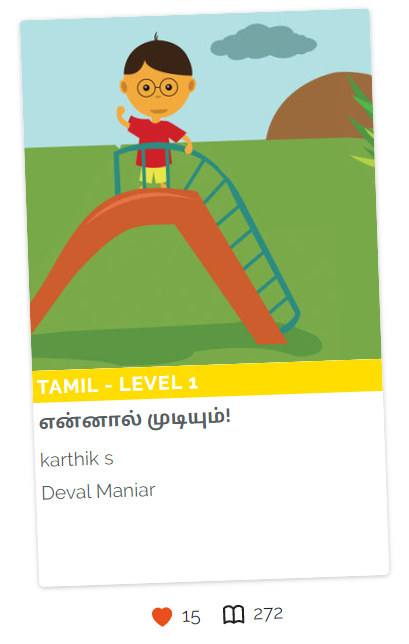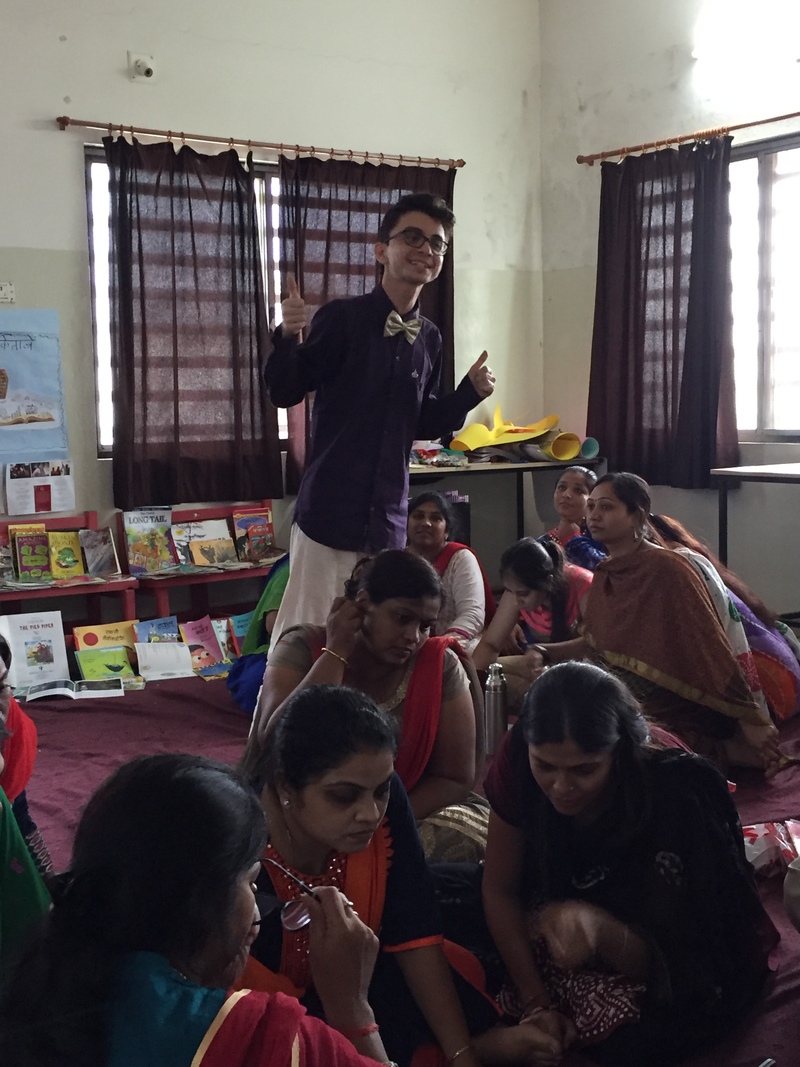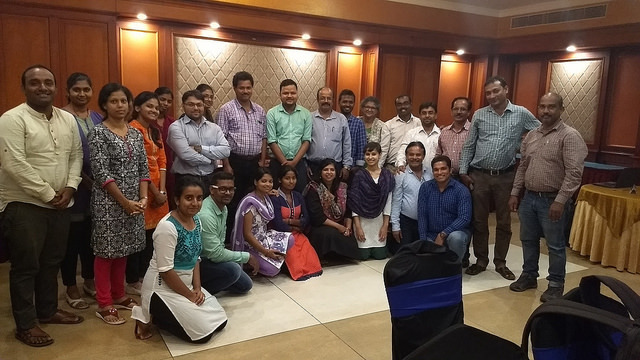On translating children's books: A Google Serve volunteer's story
Posted by Remya Padmadas on January 06, 2020Karthigeyan Sivaraj is a Google Serve campaign volunteer who has worked with StoryWeaver to help translate several storybooks into Tamil, including I Can Climb! and My Best Friend.
In this Q&A, Karthigeyan shares his experience about translating on StoryWeaver, his insight into the translation process, and his love for children's literature.

Q: Do tell us a little bit about yourself, your interests, your work
I'm a Googler by profession and by practice, and I'm proud of that! At work, being a Googler means respecting my colleagues and welcoming their opinions and ideas, howsoever different they may be to my own, and keeping things necessarily simple to my stakeholders, and I attempt to do the same outside the walls of my office as well. Having learned how to analyze data on the job, I brand myself as a data story-teller - i.e., processing data and presenting meaningful information in a way that pushes the audience to take the desired action. The interesting aspect of my job is that it allows me to improve the existing processes through imaginative ways and take ownership of some of the workflows in my organisation, thereby ensuring candidates joining Google have a lasting positive impression about their onboarding experience.
Q: Do you remember the first time you heard about StoryWeaver? What are your thoughts about the platform?
Of course, it's quite vivid in my memory the first time I heard about StoryWeaver. The concept of weaving children's stories is quite dear to my heart, and it's really gladdening to see the team working behind crafting stories as well as making them available in multiple different languages for the young audience to read and relish. I personally nurtured a similar idea a few years ago when I was an avid blogger but didn't have the imaginative power nor the enterprising capabilities to venture into this domain - I was really happy to find the StoryWeaver team doing some marvellous work in this field. Kudos to all!
Q: What was your experience of the GServe campaign, and translating books with fellow Google volunteers?
It's always a very humbling experience to take part in any GServe campaign, no matter what the cause that's being championed. The StoryWeaver campaign was very well thought through in many ways - for one, it didn't require us to sacrifice the luxury of our desks and we could contribute while at work or on the move. It was also so much fluid socializing with fellow Googlers who were taking up similar translation work. Overall, it was a rewarding experience to be able to contribute our might in little ways possible to make a huge change!
Q: We are so glad that you came on board as a commissioned translator even after the GServe campaign! What prompted you to stay in touch?
As I had mentioned previously, contributing to children's literature was always dear to me, and when I got to know about StoryWeaver's mission and their robust infrastructure, I felt relieved knowing that I didn't have to worry too much about the modus operandi, but rather focus on the work itself. With a major piece of work shouldered by the StoryWeaver team, I wanted to work with the team even after the GServe campaign, so that I could do what I like to do - writing, crafting and translating.
Q: What was your experience of being a commissioned translator? Did you pick up any new tips and techniques?
A lot I must say! One very important technique I adopted pretty early on was that I realized that translating the original work into the language of my preference required knowing the cultural nuances deeply. For instance, while translating a story from English targeting the Hindi speaking audience and translating it into Tamil would mean we will have to take into account the various cultural aspects such as the equivalent idioms used in the region. Internalizing all these cultural & regional nuances in the local language while translating is imperative if the audience has to relate to the stories. Else, they wouldn't 'stick'!
Q: How tricky is it to translate stories to Tamil? Are there any phrases that you particularly spent time on because they were difficult to translate?
Tamil, for all its richness, is a very unique language in that there are several different dialects in use across the Tamil diaspora. It becomes even trickier when you realize that the written form of the language is very different to the conversational style, and even the conversational style assumes a different shade when it comes to young audiences. Stories will have to be narrated to children in a style that's neither too formal nor too conversational and we should be ready to use a few English words that are in daily use, so they can relate to them. Also, unfortunately, tools such as Google Translate provide very literal translations of phrases which is sometimes very challenging even to the mature audience, hence you have to take a judgement call based on your own intuition and observation. I bet this is true for many Indic languages!
Q: What has been your favourite book to translate on StoryWeaver?
That's a tough one! Each of the books takes you down memory lane and makes you relive your childhood :) Be it Rani's First Day at School or the restless lad who couldn't wait to open this birthday gifts the next day or the fearless little girl - each provides a glimpse of your own childhood. For the sake of picking one, I would go for I Can Climb! which is packed with a lot of positive self-talk for young kids who are taking baby steps as they encounter different activities for the very first time in their lives.

Q: What are some of your favourite books from childhood? Is there any memorable reading moment that you would like to share?
I relished reading across different genres in both English and Tamil. In Tamil literature, especially that was taught to us in school, all messages were delivered in a cryptic fashion replete with metaphors and similes. That allowed for deep learning, situational paraphrasing and lateral thinking. For that very same reason, I preferred the works of John Milton, Rudyard Kipling & John Keats in English and innumerable poets in Tamil.
As a kid, I was an avid read of Tinkle Kids' magazines, and I used to eagerly await the next monthly edition. I am really glad to see that same level of curiosity now possessed by my niece. It seems the magazine hasn't lost its attractiveness to date!
Q: The translations you have contributed to our platform have been read over 1800 times - thank you! How has your StoryWeaver journey been? What is one big takeaway from this experience?
The biggest takeaway for me has been that we shouldn't shy away from walking in the little shoes of our young audience to truly understand what holds their curiosity and interest. Many a time, we - adult learners - tend to wear our own caps, and view children's literature in a rather lop-sided manner. However, we should be ready to speak the language of the kids (sometimes even practise prattling), simplify the language (without over-simplifying at the cost of losing the essence) to suit them and be more imaginative (what helped me to feel the pulse of the audience was to subject my work to, what I like to call, the 'niece'-test - i.e., talking to my nieces and having them vet some of my initial works)
Do leave your thoughts in the comments section below. You can also reach out to us through our social media channels: Facebook, Twitter and Instagram.
Be the first to comment.Teachers discover their inner child at StoryWeaver workshop!
Posted by Remya Padmadas on September 12, 2017Ankit Bhuptani of VIDYA, writes about a recent StoryWeaver workshop he conducted with his colleagues in Dahod, Gujarat.
I recently got an opportunity to facilitate a workshop on StoryWeaver with my colleagues Jayshree Murali and Sangeeta Gupta at Sri Sri Ravishankar Vidya Mandir, Dahod, Gujarat on 16th July 2017. Our session was was part of larger 2 day workshop on ‘Language Learning’ conducted by my organization VIDYA. VIDYA is a not-for-profit working with children, adolescents and youth in the urban slum communities of Delhi, Gurgaon, Mumbai, Bangalore and Pune. This is our 31st year having been seeded in Delhi in the home of our Founder Rashmi Misra. We have a holistic approach to education with a focus on academics, life skills and digital empowerment.

The workshop started with an introduction to the StoryWeaver platform using a short video. After this, we explored the ways to find an ideal story for the class and read a bilingual story together followed by a session on how to translate stories. This happened in small groups of 5 teachers each who logged-in on the platform and translated a story. Now was the time to create our own. But….. suddenly the power was gone! And we had to find our own ‘power'!

What fun it was to weave and spin a story based on the pictures which we had downloaded from very rich picture pitara of StoryWeaver. The story was about two children Pinku and Pinky who go to a jungle in search of their cat Biladi. All the teachers were immersed and the child in them surfaced.
The whole workshop not only helped teachers to understand the platform of StoryWeaver but also helped to develop important teaching skills like group building and critical thinking. The teachers felt that integrating technology in the classroom via stories was a brilliant idea.
Be the first to comment.Workshop Announcement: Reading with StoryWeaver in Namma Bengaluru
Posted by Remya Padmadas on August 30, 2018StoryWeaver invites educators and resource people from organisations to attend a workshop to be held in Bengaluru on 6th and 11th September in Koramangala. Participants will gain an understanding of how to use StoryWeaver with the children they work with. This includes how to:
-
Browse, read & curate a reading list from over 9000 stories across 118 languages
-
Download stories for offline reading
-
Create a new story or a set of flashcards from an image bank of over 11000 illustrations
- Re-Level / Re-Mix a story to suit your child's needs
- Translate stories to a language of your choice
And best of all, ALL of this is absolutely FREE!
To celebrate language diversity, we are planning to conduct the workshop session in English on the 6th and in Kannada on the 11th. You are requested to give your preference for the date/language while signing up. However, just in case we are not able to attract enough participatio
The workshop would cover the following:-
- A demonstration of StoryWeaver and the platform's key functionalities
- Examples of how educators are using StoryWeaver effectively in their classrooms
- Dedicated work time for participants to try their hands on StoryWeaver
- An opportunity to meet other educators and have interesting conversations

Participants at a recent StoryWeaver workshop.
If this excites you, REGISTER HERE to book your place in the workshop, latest by 3rd September, Monday.
Please note that the seats are limited and we might not be able to accommodate more than 2-3 people per organization. Confirmed participants will get a separate email confirming their participation and other logistical details.
The workshop will be held between 10 a.m to 4.30 p.m and there is no fee to attend the workshop.
Feel free to reach out with any questions to Khyati at [email protected].
comments (3)